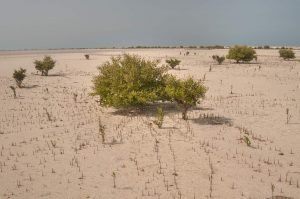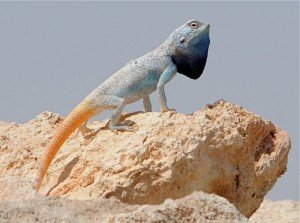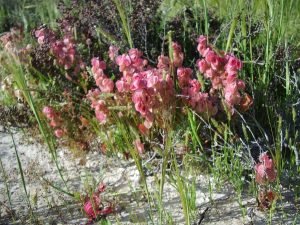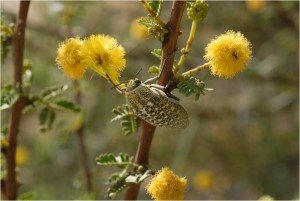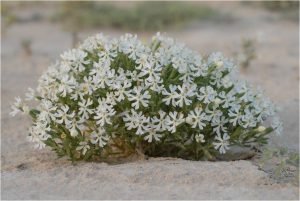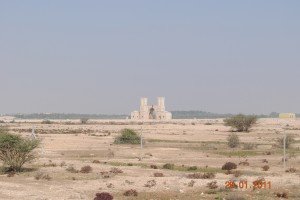
When I first moved to Qatar ten years ago, I was disappointed to find that the desert of the Qatar peninsula (on the northeastern coast of the Arabian peninsula) was not as lush as that of Arizona, where I previously had lived and fallen in love with Sonoran plants and animals. At first, Qatar’s desert appeared to be nothing but a barren wasteland.
Then I was introduced to a local artist and wildflower expert who, every spring after the rains, took us out into the desert to search for flowers and other treasures, animals like the Blue-headed agama, the Horned viper and the Sand cat.
Prior to moving to Qatar, where I teach at Virginia Commonwealth University in Qatar, my poetry had been mainly focused on human rights and people’s experiences. But in this new harsh environment, I found myself writing about the natural world. Since Qatar soon will have its own botanical garden, I began drafting poems that describe the benefits and uniqueness of particular plant species endemic to the Arabian Peninsula.
I now want to promote the beauty and fragility of Qatar’s ecology and flora and encourage readers to become more involved and connected to this desert environment.
My chapbook,
Desert Ecology: Lessons and Visions is a glimpse of my research.
THE HARDY ONES
As for those flowers cropping up where
least expected—hard-packed drifted sand,
shifting dunes, fossil corals,
among rocks and granite outcrops –
I would be so fool-hardy and daring,
delighting and surprising, a feast
for famished eyes under scorching sun.
Flowers that ignore pipelines,
oil rigs, keep-out signs, country borders,
undeterred by endless sunny days and
cloudless skies over a hot subtropical desert.
Across the landscape – from flat terrain
to wavy hills to sand dunes – they bloom,
undaunted by wind-blown dust and sandstorms,
dry wadis and runnels, course-textured arid soil.
Out of rodat, sabkha,
saline deposits, rocky Lithosol,
sandy soil, they grow – ephemerals,
annuals, dwarf woody perennials you need
to see to believe: Cistanche tubulosa rising up
out of the sand; Calendula arvensis sprouting
from a rocky outcrop; Launaea capitata
pushing through hard-packed sand.
From a distance you’ll see nothing, but go
with my wildflower expert friend, and you’ll swear
he’s pulling them out of a hat – nothing there,
then just like that he leans down and whispers,
Here. Cradled in a shell midden,
all but hidden away, a rock rose,
Helianthemum lippii hosting the treasured
desert truffle, fuga. Then he leads you
further along – there, out of a hat,
the desert campion; and there,
the caper plant, Capparis spinosa.
Finally, you don’t need him; you’re getting
the knack of it: you see the flora famous
for sheltering scorpions, red arta.
Returning home to your pampered
walled-in garden, you feel unimpressed
with bougainvillea, lantana, frangipani;
you dream all night of the hardy ones –
steadfastly noble in their earnest labors,
convincing anyone who’ll kneel at their roots
a lifetime’s not long enough to seek out
blooming sages of the most desolate places.
You’ll feel the only confessing you need
to do is to the desert wildflowers – they
with their infinite faith and powers the ones
who can call you back to your rightful place
in the eternal scheme of things.
DESERT ECOLOGY LESSON 4: SABKHAS
That night, after a day spent
on the coastal margins, I dreamt
I was a sabkha gently emerging
from the sea, displaying my fine silt
and calcareous sands like a proud weaver
of silk carpets and kalims.
I showcased my mangroves –
Avicennia marina – and my halo-
phytic plant communities:
Arthrocnemum glaucum, Juncus
rigidus, Aeluropus lagopoides.
Mobile dunes encroached on me, confining
my vegetation to the lower level
between the cusps of coalesced dunes.
I glistened in the harsh sun,
gypsum crystals adorning me.
My silt and sands spread out between
sea and the cracked earth
of packed desert pavement.
I proved a moist treasure trove
for Slender-billed gulls, whimbrels,
sandpipers and crabs.
But whose waste was seeping
into my heart? Oblivious,
a Little Stint before day was spent
came to peck about my mudflats,
moving among plastic bags
and other trash, taking just enough
to sustain it.
—-Diana Woodcock
In 2013, Diana Woodcock received a Presidential Research Quest Fund Award from Virginia Commonwealth University. The research project purpose is to promote the beauty and fragility of Qatar’s ecology and flora and encourage readers to become more connected to this desert environment so they will get involved with projects to protect it.
Diana conducted research aimed at connecting environmental issues to physical and psychological needs of human beings. Her goal was two-fold: (1) to highlight with poetry the benefits of sustainable development and how Qatar could be a pioneer of environmental conservation while satisfying industry demands; and (2) to stimulate, with research-driven poetry, the reader’s environmental sensitivity to both personal and planetary health.
Her chapbook, Desert Ecology: Lessons and Visions, the final outcome of which will be a full-length collection of poems featuring Qatar’s ecology and flora, as well as the twenty-two plants most often mentioned in the Quran.
Sand Cat
Rumex vesicarius; pink flowers, photographer Fay Gotting
Acacia plant; yellow flower with bug, photographer Susan Madizia
Silene arabica; white flowers, photographer Susan Madizia
Follow us!Share this post with your friends.

